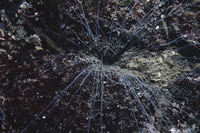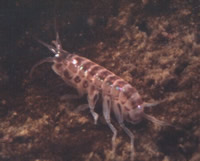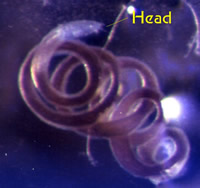|
The Infamous Detritivore
For several years, I have been recommending
and suggesting that aquarists add "detritivores"
to their sand beds and to their reef systems, in general.
A short time ago, I was asked, "Just what is a detritivore
and why should I add some to my tank." In essence, this
aquarist wanted to know why in the world that he should pay
a lot of money for animals that generally are invisible. And
even worse, why pay for animals that when they are not invisible,
are ugly? Well, I thought the answer was obvious. Then, I
thought, well, maybe it is obvious, but only if you are a
marine ecologist who has spent a lot of time working with
these kinds of animals. But for the average hobbyist, the
questions I was asked were really pretty good ones, and definitely
raise some valid points.
 |
Figure 1. Although many different
kinds of worms are referred to as Spaghetti worms, "true"
spaghetti worms or terebellid polychaetes have many long
tentacles arising from the head. These tentacles range
out from a burrow in rock or sediment to collect the small
particulate detritus that the worm feeds on. |
To get to the end of this discussion, and
to answer those questions, though, I need to start with the
concept of detritus and discuss it. I will then discuss several
different kinds of detritivores and their importance to marine
aquaria.
Detritus - A Multitude of Sins
As words go, "detritus" is nice; it is short and
even I can spell it correctly (at least most of the time).
The word is concise and easy to say. Only its meaning is ambiguous.
The term "detritus" is actually a word of Latin
derivation and it means a "rubbing or wearing away."
As is generally understood, detritus is fine particulate material
that is eroded off of larger particles. In our systems, detritus
is the small particulate material resulting from either the
biological or physical processing of food, living things,
or substrata. Often this is waste material from some relatively
large organism. So, "detritus" means small particulate
material of uncertain and variable origin.
There is a tendency for aquarists to consider that this particulate
material is simply composed of fine mineral grains. And some
small portion of it is. But most of it is not. Most of it
is organic, and therein lies the problem. Much of this detritus
is the remains of uneaten food, specifically, particulate
food such as dried flake food. Another large component is
fecal material from both fish and invertebrates. The fecal
component is effectively the same thing as uneaten food. Even
though we tend to think of feces as being waste material,
in point of fact for aquarium animals, they are simply the
indigestible residues of food, often with a healthy dose of
digestive enzymes in it. In other words, it is uneaten, partially
processed food. Other sources of detritus are the breakdown
products of algae. These products include mucus, various other
exudates (algae are very "leaky") and decomposing
algal tissue. These materials are highly organic, and many
animals find them quite nutritious.
Detritus may also be formed from animal byproducts. Corals
and other cnidarians produce very significant amounts of mucus.
Mucus may either dissolve in water or form small relatively
insoluble aggregates. Additionally, sloughed animal cells
also contribute to detrital formation. All animals recycle
their covering cells (from epithelial tissue) at a rather
rapid rate, and the amount of cellular debris which is shed
in an aquarium may actually be quite considerable.
Additionally, detritus may be formed by some types of bacterial
aggregations. These may result from the feeding activities
of animals, but often they are simply a result of bacterial
growth. Under favorable conditions, the marine bacteria in
our tanks may grow and divide rapidly, sometimes several times
an hour. Bacteria often surround themselves with mucilaginous
coats. These coats tend to stick together, and result in small
clumps of bacteria otherwise known as particulate organic
matter or detritus.
Finally, detritus can be composed of inorganic mineral grains
resulting from the actions of animals burrowing in live rock
or coral skeletons, or from ingested larger mineral grains
which are only partially dissolved in digestion. Most of these
mineral grains are covered with some bacterial growth and
hence they have a "frosting" of some edible material
over the mineral itself.
An examination of all of the above ways that detritus may
be formed should convince you that detritus is basically organically
rich particulate material. The mineral component of detritus
is simply small silt or clay-sized particles (0.063 µm
or smaller particles) covered in organic material. This composition
means two things: 1) detritus may be a useful as food, and
2) detrital accumulations are nutrient "time-bombs"
waiting to go off.
The organic matter in detritus is loaded with carbohydrates,
such as sugars and starches, nitrogen-rich proteins, and some
lipids. In many ways, detritus is an ideal food source and
much of it is quite rich. Left alone in a reef tank, it will
become subject to chemical and biological decomposition. This,
in turn, will cause a spike of dissolved nutrients. And from
these spikes will come undesirable algal blooms.
Detritus Control
The problem for aquarists is that detritus amounts to condensed
nutrient, and can lead to all sorts of other problems. Consequently,
we need to remove it from our systems. This leaves us with
several options. We can try to reduce detritus formation.
Alternatively, we can accept that our systems will have detritus
formation. If we do the latter, we must either remove it,
or allow our systems to live with it. Let's look at these
alternatives.
Reduce Detritus Formation
The most obvious way to reduce detritus formation is to reduce
the food input to the system, and this was the cure for "the
detritus problem" in the early days of reef keeping.
However, we know that all stony corals and most soft corals
need to feed, and they need to feed a lot to get the materials
they need to grow and remain healthy. Basically, putting these
animals as well as the fish on a starvation diet is both irresponsible
and unethical. The animals become severely stressed from malnutrition,
and are more prone to diseases, parasites, and other mortality
factors such as attacks from nearby competitors.
Another way to reduce detritus formation is to keep the animals
cool, at the lower limit of their temperature tolerance. For
every Fahrenheit degree of cooling, coral reef animals will
lose between three and five percent of their metabolic rate.
Such animals don't need to feed much, nor do they produce
much in the way of excess particulate matter. Unfortunately,
they also don't grow, and don't have any metabolic excess
to fight off diseases, and finding a low temperature extreme
is tricky. Many corals are not found at temperatures below
about 76 F, and as they near this temperature their metabolic
processes slow down to where they are barely living.
Allow Detritus Formation: Remove the Detritus
This alternative, while labor intensive, works pretty well.
Probably the easiest way that this can be done is to keep
a bare bottom tank, with minimal live rock and good bottom
circulation. The water is continuously mechanically filtered,
and the tank bottom is frequently siphoned clean. To ensure
that all the detritus is removed, the aquarist must have a
schedule that ensures regular cleaning and water changes.
This alternative works particularly well for fish only tanks
or invertebrate species tanks with a minimal number of occupants.
It does require a lot of monitoring to ensure that the nutrient
levels don't get out of hand.
Allow Detritus Formation: Live With It And
Let the Critters Control It
Living with detritus is, of course, Momma Nature's way of
dealing with the stuff. To understand how detritus is dealt
with in nature and how we may design our systems to deal with
it, we need to realize that detritus contains a LOT of useful
material. It contains all the necessary foods: carbohydrates,
proteins, fats, and minerals. Some of these foods, such as
the carbohydrates and lipids, can be converted directly into
the chemical energy that organisms need to fuel their bodies'
metabolism. The proteins may be broken down (or digested)
into amino acids and then resynthesized into the organism's
own proteins. Bacteria are perhaps the best possible foods
in this regard, as they have a higher nitrogen to carbon ratio
than do food derived from most multicellular organisms. Because
nitrogen compounds are the building blocks of proteins, this
means that bacteria are very useful foods when it comes to
building or repairing tissues. In other words, in the natural
world, detritus is an exceptionally valuable resource.
 |
Figure 2. Several different,
but similar appearing, species of amphipod crustaceans
are found commonly in aquaria. Although different amphipods
may feed in just about every way known, most of the ones
in reef aquaria feed by tearing plant debris and organic
detritus into "bite sized" pieces and eating
it. |
It should not seem surprising, then, that
a wide variety of organisms have become adapted to eat or
utilize detritus. One of the more interesting side effects
of eating anything, including detritus, is that it creates
detritus. This is due to one of the inviolate natural laws,
the second law of thermodynamics, which holds that no transfer
of energy or materials is one hundred percent efficient. Some
energy or material is always lost back to the environment.
What this means in practical terms is simple: to reduce the
energy and useful materials in a given amount of detritus
to insignificance will mean that that particular parcel of
detritus must be eaten and digested several times. The number
of these "reprocessing" events may be quite numerous.
For example, it has been estimated that an average pelagic
copepod fecal pellet released near the surface of the ocean
is eaten and re-eaten about eight times before it makes it
to the ocean bottom.
Turning the "multiple use of each detritus particle"
information in the above paragraph around a bit, this means
that to fully process a given quantity of detritus can take
a rather large number of animals. Also, given that the "quality,"
the "consistency," and the food value of the detritus
will change after each organism is done with it, it will also
take a number of different kinds of organisms each specialized
for a different type of detritus, to fully process it.
The Fate of Detritus
When detritus is eaten it is processed like any other food.
First, it is digested. Some of it will be indigestible and
this will be passed out the animals as feces, presumably to
form more detritus. Some of the digested food, mainly the
amino acids and protein fragments that made up part of the
original detritus particle, will be assimilated into the body
of the organism and used to build or repair tissues. Some
of these will eventually be recycled and eliminated from the
organism's body as ammonium ion in urine. Much of the rest
of the digested foods, primarily the carbohydrates (sugars
and starches) and most of the lipids (triglyceride fats) will
be utilized in cellular respiration, or in other words, they
will be burnt to produce energy. Eventually they get eliminated
from the organism as carbon dioxide and water. Some of the
lipids (steroids) will be utilized to synthesize other steroids.
Many animals utilize steroids as hormones, but a lot of those
animals cannot synthesize them and must get them from their
food. These will eventually be broken down and used in cellular
respiration. Minerals that were digested, primarily during
acidic digestive processes, may be used for skeletal materials
or co-factors in enzymes.
Notice in the above paragraph that the only things to actually
be exported from the aquarium by detritus processing are carbon
dioxide from cellular respiration, and ammonium ion from protein
metabolism. The ammonium may eventually be processed by bacteria
and reduced to nitrogen gas, which would exit the system at
the water-air interface. Each time one of the detritivores
is eaten by some other animal in the natural or artificial
ecosystem, it is recycled in much the same way. If there are
enough different animals in the system, with the appropriate
feeding preferences, virtually all the organic carbon compounds
and nitrogen containing compounds in food, be it fresh food
or detritus, may be exported from the system.
Although most detritus eating animals are small creatures,
the total amount of carbon and nitrogen exported from a large
aquarium may be quite considerable. If one is feeding half
an ounce of food per day, and this may be barely adequate
amount for a moderately sized aquarium (about 100 gallons),
that is a shade over 11 pounds of food added to the tank in
a year. Some of this will go to build more critter flesh,
but much of it will be exported as carbon dioxide or nitrogen
derived ultimately from animal urine.
Reef Aquarium Detritivores
The answer to the question, "What is a detritivore?"
is both simple and complex. Simply put, it is an organism
that eats detritus. The question becomes more complicated
in trying to specify just what organisms do this. There are
alot of potential animals that may be called detritivores
(Table 1).
|
Table
1. Some properties of common aquarium detritivores.
Each category may contain several species. Sizes and
properties refer only to aquarium animals, maximum sizes
in nature are generally much larger.
|
| Animal Type |
Feeding Type
|
|
| Common
Name |
Scientific
Term |
Particle
Scraper |
Particle Feeding
|
Maximum
Size |
| Surface |
Subsurface |
| Amphipod |
Amphipod |
X
|
X
|
X
|
1 - 10 mm |
| Copepod |
Harpacticoid
Copepod |
X
|
X
|
X
|
0.1 mm |
| Nassarius |
Nassarius |
|
X (carrion feeder)
|
1 cm |
| Cerith Snail
|
Cerithiid Snails
|
X
|
X
|
X
|
3 cm |
| Mini-Stars
|
Brittle Star
= Amphiurid Ophiuroid |
|
X
|
|
1 - 15 mm |
| Non-brittle Star
= Asterinid Asteroid |
X
|
X
|
|
10 mm |
Spaghetti
Worms (At various times, worms in all of these groups
have been called spaghetti worms.) |
Terebellid
Polychaete
Annelid |
|
X
|
|
Body = 20 mm Tentacle
span = 60 cm |
Chaetopterid
Polychaete
Annelid |
|
X
|
|
Body = 1 cm Tentacle
span = 5 cm |
Cirratulid
Polychaete
Annelid |
|
|
X
|
Body = 6 cm Tentacles
not used in feeding |
| Bristle Worm,
Fire Worm |
Amphinomid
Polychaete
Annelid |
|
X
|
X
|
50 cm |
| Worm,
Bristle Worm |
Maldanid
Polychaete
Annelid |
|
|
X
|
7.5 cm |
Lumbrinerid
Polychaete
Annelid |
|
|
X
|
10 cm |
Arenicolid
Polychaete
Annelid |
|
|
X
|
3 cm |
| Flatworms |
Turbellarian
|
|
X
|
X
|
5 mm |
| Roundworms |
Nematode |
X
|
X
|
X
|
10 mm |
| Forams |
Foraminiferan
|
|
X
|
X
|
1 mm |
| No
Common Name |
Gastrotrich |
|
X
|
X
|
0.1 mm |
| Ciliated Protozoan
|
|
|
X
|
0.3 mm |
This is a rather large array of animals,
and interestingly enough, only a few of them are likely to
be visible and commonly seen by aquarists. Many of the smaller
animals are either over-looked, or are simply invisible to
the unaided eye. Most of those animals that feed below the
surface of sediments burrow through the sediments and are
likely to be seen only when the aquarist disturbs or changes
the sediments.
 |
Figure 3. Nematodes,
or roundworms, are common in reef tanks. This particular
one, removed from my lagoonal reef tank, was about 1 cm
long. Many free-living nematodes are predatory, others
eat organic detrital particles.
|
Most reef aquaria that have been
set up for more than a few months, and which have had fresh
live rock or good live sand added, probably have representatives
of most, if not all, of these groups. The sizes of the organisms
in the groups are critical. To have a functional "guild"
of detritivores, all sizes from very large to very small must
be present in our systems. In a very real sense, the sizes
of the animals in the detritus food webs runs the reverse
of what we see elsewhere, where each succeeding level in a
food web is larger. Here, large animals eat large particles,
and convert the detritus into smaller particles, which in
turn are eaten by smaller detritivores. These also convert
the particles into yet smaller particles, which get eaten
by yet smaller detritivores, and so on all the way down to
microorganisms.
Conclusion
While all sizes and types of detritus feeding organisms are
necessary for optimal processing of extraneous debris and
organic materials in our systems, only a very few of these
animals are available directly from dealers. Most of the smaller
ones, particularly, must come in a rather hit-or-miss manner
from our additions of live rock and live sand. It is very
important for the establishment of a deep sand bed, and the
concurrent maintenance of a low dissolved nutrient level in
our systems, that a varied fauna of these "micro-food"
processors is established and maintained.
|

